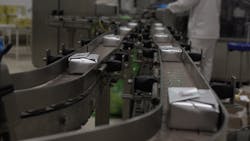3 Key Tips for Buying the Right Machinery for Dairy Packaging
Fill-seal and/or form-fill-seal equipment is an essential part of operations for most dairy processors. After all, these pieces of equipment ensure that a product is accurately and seamlessly placed into primary packaging before continuing down the production line.
There's a lot to consider when selecting machinery for a plant, and many potential hurdles to avoid after the purchase. Max Davis, head of customer success at WNA, provides 3 key tips that customers should consider before purchasing dairy packaging equipment.
1. Customize It
A common mistake among dairy processors’ filling equipment selection processes is the disregard for the interaction between a product and its packaging on the line. Some manufacturers think that packaging is interchangeable and don’t consider this part of the equation when they select a filler.
“We run into problems most often when equipment isn’t properly engineered to the exact package and product you’re looking to run,” Davis says. He explains processors should take a “holistic approach” during product development—one should consider the exact product and packaging specs for manufacturing.
"Waldner, for example, designs custom equipment, so we take information about specific operational needs and create the filler that would be appropriate for a given product and its packaging,” he says.
2. Prioritize Flexibility
Not all dairy products are created equal in terms of how easily they interact with filling equipment. For example, butter and cream cheese are far more complex to fill than other products. Butter can be difficult because solids separate out very easily, so manufacturers must be careful when dosing. Conversely, cream cheese is a challenging application because it’s thick and filled into containers when it is cold, making it difficult to package the product easily.
Davis re-emphasizes the importance of understanding a product and its packaging specs, especially when running different types of dairy products in the same equipment.
“It’s crucial to operate flexible machines to ensure the highest levels of efficiency when changing between products and formats,” he says.
3. Value Maintenance Service
Dairy processors must build an effective preventative maintenance plan once the appropriate equipment is selected. Manufacturers should not wait for something to fail to replace equipment parts.
“It's ultimately much more expensive for companies to replace failed machine parts as opposed to keeping up to date on what needs to be changed. Once you’re running to failure, you’re going to have cascading issues across the machine,” Davis says. “A well-considered preventative maintenance plan is essential. It will minimize unplanned downtime and maximize output.”
He recommends that processors should choose a machine manufacturer that will help them implement and execute an effective maintenance program tailored to their packages, products, and personnel.
Max Davis is the Head of Customer Success for Waldner North America, a manufacturer that specializes in the automated filling and sealing machinery for shelf-stable cups, trays, pouches, and spouted pouches for fresh and cultured dairy products, baby food, pet food, prepared foods, and ready meals. You can contact Max at [email protected] or (412) 334-8616 or visit https://www.wnapt.com/home.
About the Author
Max Davis
Max Davis is the Head of Customer Success for Waldner North America, a manufacturer that specializes in the automated filling and sealing machinery for shelf-stable cups, trays, pouches, and spouted pouches for fresh and cultured dairy products, baby food, pet food, prepared foods, and ready meals.

